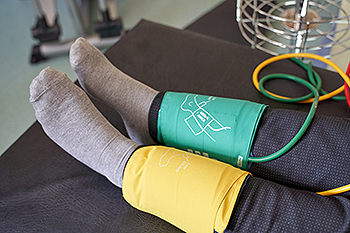
Peripheral artery disease is caused by narrowed or blocked arteries that reduce blood flow to the feet, toes, and ankles. One effective way to diagnose peripheral artery disease is through the ankle-brachial index test, or ABI, which measures blood pressure at the ankle and the arm while at rest. In some cases, the test is repeated after a brief period of exercise, such as walking, to evaluate changes in blood flow. A normal result, with an ankle-brachial index of 1.0 to 1.4, indicates healthy blood flow. A lower or higher ratio may indicate peripheral artery disease, which can lead to pain, numbness, or slow-healing wounds in the feet and ankles. A podiatrist can conduct ABI testing and offer guidance to reduce the risks of further complications like ulcers or infections. If you have symptoms of peripheral artery disease, it is suggested that you schedule an appointment with a podiatrist for a diagnosis and treatment.
Peripheral artery disease can pose a serious risk to your health. It can increase the risk of stroke and heart attack. If you have symptoms of peripheral artery disease, consult with one of our doctors from Intercoastal Medical Group. Our doctors will assess your condition and provide you with quality foot and ankle treatment.
Peripheral artery disease (PAD) is when arteries are constricted due to plaque (fatty deposits) build-up. This results in less blood flow to the legs and other extremities. The main cause of PAD is atherosclerosis, in which plaque builds up in the arteries.
Symptoms
Symptoms of PAD include:
- Claudication (leg pain from walking)
- Numbness in legs
- Decrease in growth of leg hair and toenails
- Paleness of the skin
- Erectile dysfunction
- Sores and wounds on legs and feet that won’t heal
- Coldness in one leg
It is important to note that a majority of individuals never show any symptoms of PAD.
Diagnosis
While PAD occurs in the legs and arteries, Podiatrists can diagnose PAD. Podiatrists utilize a test called an ankle-brachial index (ABI). An ABI test compares blood pressure in your arm to you ankle to see if any abnormality occurs. Ultrasound and imaging devices may also be used.
Treatment
Fortunately, lifestyle changes such as maintaining a healthy diet, exercising, managing cholesterol and blood sugar levels, and quitting smoking, can all treat PAD. Medications that prevent clots from occurring can be prescribed. Finally, in some cases, surgery may be recommended.
If you have any questions, please feel free to contact our offices located in Bradenton, and Sarasota, FL . We offer the newest diagnostic and treatment technologies for all your foot care needs.
